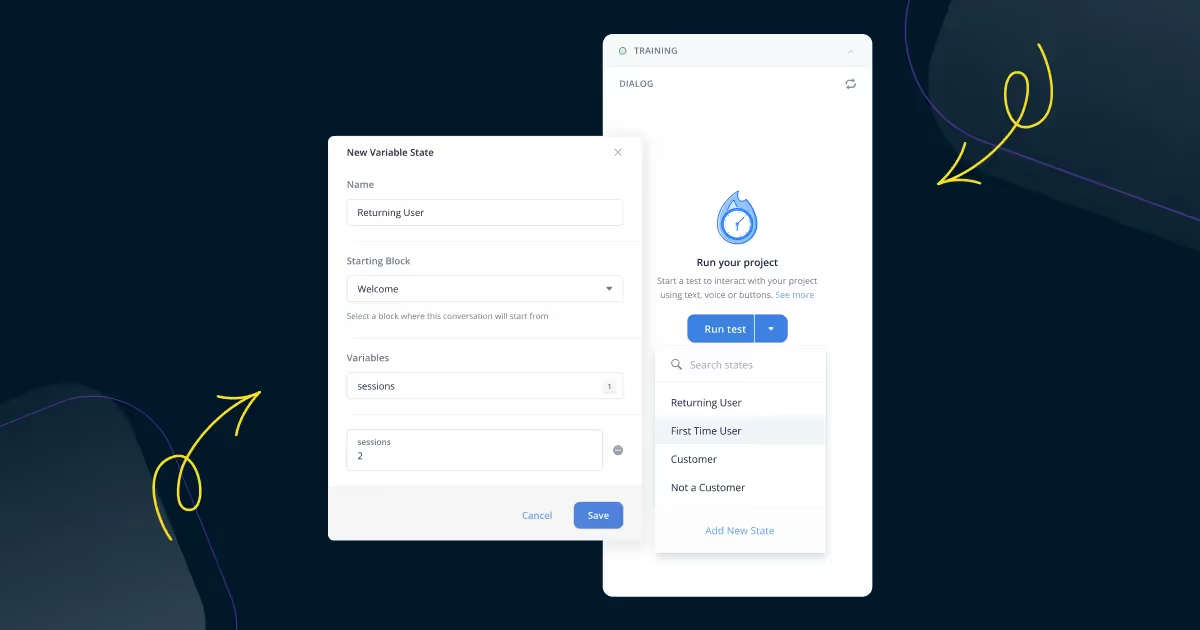1. Rethinking the linear web interface
Conventional website design and information architecture tend to be linear, emphasizing headlines and hierarchy. But why? Because it was based on paper documents? Computers no longer have to think linearly, neither do we, and I think UX designers can help us break out of this.
If we joined forces with UX designers, we could create far more dynamic user interactions with websites and dashboards. Rather than dashboards being a big grid of tiles, users could simply ask an assistant questions about the data. Those users would no longer need to use a mouse to point and click. You wouldn’t even have to train them on the dashboard—only on asking questions.
And this is just one idea. I’m not even a UX designer. I think they could utterly revolutionize the AI landscape by introducing novel interaction patterns that transcend traditional chatbot constraints. They could integrate features like adaptable conversation flows, context sensitivity, and dynamic interfaces.
"If we joined forces with UX designers, we could create far more dynamic user interactions with websites and dashboards."
Because again, UX designers aren’t starting with the technology. They’re starting with people and their intents. And just like the Google Assistant team knows, users don’t always want to repeat the wake word. It’s unnatural. Instead, they want to engage in a more organic back and forth. The result is more fluid and human-like.
UX designers could help us answer the question: How could everything about CAI be more fluid and human-like?
2. Building micro interfaces (UIs) and ephemeral apps
Generative AI can code. With that realization comes the reality that many apps may soon cost nothing. There’ll always be a place for the large-enterprise, high-design, high-security iOS app, or the voice assistant that creates a genuinely delightful experience, but if you want to build your own tiny app and run it in your own environment? That’s basically free.
Smart people are predicting this will create a category of what is known as “ephemeral apps” and micro user interfaces.
Ephemeral apps will need to be easy to use
The idea with ephemeral apps is if your assistant knows what you want to achieve, it can field-code its own tiny, temporary app to help you accomplish this task. For example, it could amalgamate shopping lists, recipe suggestions, and guest list management into one tool for a dinner party. And once the party is over, the app would disappear, leaving no trace of its existence.
Those sorts of applications will need clear and intuitive conventions, drawn from everything UX designers already know about such interfaces.
Micro interfaces will need to know how people think
Your assistant will be able to code a new micro interface to display or collect information in a format that’s even more intuitive than text chat. For example, “Okay, please adjust these color selectors,” “Assemble your ideal car,” or “Here’s your personal calendar, why don’t you select a time when you’d like a callback in between your work?” The assistant could design those interactions to reveal these UI elements as users progress through the conversation to make the conversation much easier.
The entire micro UI would be custom to that user and situation. And it’d need to follow UX design principles to ensure it is, in fact, easier and more satisfying than the alternative.
3. Integrating UX research into the CAI process
I’ve often tried to get a UX designer on our team at past companies, but of course, budgetary constraints stopped us. That’s usually the only rational objection to having a truly multidisciplinary CAI team. But let’s say you’re able to hire someone or borrow them from another team. Then, you’ll need to shift the way you work to make room for their contributions.
I’ll bet you’ll want to include them in the whole process, but be very tactical about what projects you most need their input on at the start, middle, and end.
- At the start, you want them asking questions like, “Why is our default assumption that users want a form?” and “What data do we have about how users are actually interacting with these elements today?”
- In the middle, you’ll want to make space for them being the user’s champion, and asking, “But are people actually asking for this? Is this truly a problem that needs solving?”
- And throughout, but especially at the end, you want them doing UX research—talking to customers to figure out what they were hoping to accomplish, how it went, and areas that you might improve.
At first, they may have to unlearn the linear interface
It’s also probably the case that many UX designers schooled in linear web design won’t yet understand what a profound shift CAI is having on the way we interact with websites, apps, and data. It may take a moment to get their head around the fact that everything they know about page hierarchy and presentation is no longer the center of the known universe—that there are other planets. (Especially because they’ve probably only interacted with mediocre chatbots.)
But I’m convinced those who see the potential for things like non-linear interfaces, micro UIs, and ephemeral apps will understand. And they’ll help you completely rethink how you’re going about it.
Let’s party like it’s 1999
So what happened in 1999? TiVo launched. It was a set-top box that recorded TV while it played so you could pause, fast forward, and rewind just like with any recorded medium. Unlike any of its predecessors, TiVo was loved. The remote was obvious and simple. Once set up, anyone in the family could work it. It was so successful, it was a commercial failure—it was so heavily copied, it’s now an intrinsic feature of most TVs and presaged the entire streaming era.
For a few years, TiVo was a verb. It won awards. And it normalized the idea that one ought to be able to record and watch shows at will. It was the revolution the Cartrivision had wished for.
And it was a revolution because of its UX.
Here’s a bonus: How to make a case for a UX designer
- Identify the biggest performance challenges your CAI team faces
- Identify your boss’ targets and the most important thing they’re measured on
- Quantify the opportunity cost to their targets in not addressing these challenges
- Propose ways a UX designer might address those challenges
- Quantify the benefit of having those challenges fixed
- Present this to your boss in the above order
- Tell them I sent you!
1. Rethinking the linear web interface
Conventional website design and information architecture tend to be linear, emphasizing headlines and hierarchy. But why? Because it was based on paper documents? Computers no longer have to think linearly, neither do we, and I think UX designers can help us break out of this.
If we joined forces with UX designers, we could create far more dynamic user interactions with websites and dashboards. Rather than dashboards being a big grid of tiles, users could simply ask an assistant questions about the data. Those users would no longer need to use a mouse to point and click. You wouldn’t even have to train them on the dashboard—only on asking questions.
And this is just one idea. I’m not even a UX designer. I think they could utterly revolutionize the AI landscape by introducing novel interaction patterns that transcend traditional chatbot constraints. They could integrate features like adaptable conversation flows, context sensitivity, and dynamic interfaces.
"If we joined forces with UX designers, we could create far more dynamic user interactions with websites and dashboards."
Because again, UX designers aren’t starting with the technology. They’re starting with people and their intents. And just like the Google Assistant team knows, users don’t always want to repeat the wake word. It’s unnatural. Instead, they want to engage in a more organic back and forth. The result is more fluid and human-like.
UX designers could help us answer the question: How could everything about CAI be more fluid and human-like?
2. Building micro interfaces (UIs) and ephemeral apps
Generative AI can code. With that realization comes the reality that many apps may soon cost nothing. There’ll always be a place for the large-enterprise, high-design, high-security iOS app, or the voice assistant that creates a genuinely delightful experience, but if you want to build your own tiny app and run it in your own environment? That’s basically free.
Smart people are predicting this will create a category of what is known as “ephemeral apps” and micro user interfaces.
Ephemeral apps will need to be easy to use
The idea with ephemeral apps is if your assistant knows what you want to achieve, it can field-code its own tiny, temporary app to help you accomplish this task. For example, it could amalgamate shopping lists, recipe suggestions, and guest list management into one tool for a dinner party. And once the party is over, the app would disappear, leaving no trace of its existence.
Those sorts of applications will need clear and intuitive conventions, drawn from everything UX designers already know about such interfaces.
Micro interfaces will need to know how people think
Your assistant will be able to code a new micro interface to display or collect information in a format that’s even more intuitive than text chat. For example, “Okay, please adjust these color selectors,” “Assemble your ideal car,” or “Here’s your personal calendar, why don’t you select a time when you’d like a callback in between your work?” The assistant could design those interactions to reveal these UI elements as users progress through the conversation to make the conversation much easier.
The entire micro UI would be custom to that user and situation. And it’d need to follow UX design principles to ensure it is, in fact, easier and more satisfying than the alternative.
3. Integrating UX research into the CAI process
I’ve often tried to get a UX designer on our team at past companies, but of course, budgetary constraints stopped us. That’s usually the only rational objection to having a truly multidisciplinary CAI team. But let’s say you’re able to hire someone or borrow them from another team. Then, you’ll need to shift the way you work to make room for their contributions.
I’ll bet you’ll want to include them in the whole process, but be very tactical about what projects you most need their input on at the start, middle, and end.
- At the start, you want them asking questions like, “Why is our default assumption that users want a form?” and “What data do we have about how users are actually interacting with these elements today?”
- In the middle, you’ll want to make space for them being the user’s champion, and asking, “But are people actually asking for this? Is this truly a problem that needs solving?”
- And throughout, but especially at the end, you want them doing UX research—talking to customers to figure out what they were hoping to accomplish, how it went, and areas that you might improve.
At first, they may have to unlearn the linear interface
It’s also probably the case that many UX designers schooled in linear web design won’t yet understand what a profound shift CAI is having on the way we interact with websites, apps, and data. It may take a moment to get their head around the fact that everything they know about page hierarchy and presentation is no longer the center of the known universe—that there are other planets. (Especially because they’ve probably only interacted with mediocre chatbots.)
But I’m convinced those who see the potential for things like non-linear interfaces, micro UIs, and ephemeral apps will understand. And they’ll help you completely rethink how you’re going about it.
Let’s party like it’s 1999
So what happened in 1999? TiVo launched. It was a set-top box that recorded TV while it played so you could pause, fast forward, and rewind just like with any recorded medium. Unlike any of its predecessors, TiVo was loved. The remote was obvious and simple. Once set up, anyone in the family could work it. It was so successful, it was a commercial failure—it was so heavily copied, it’s now an intrinsic feature of most TVs and presaged the entire streaming era.
For a few years, TiVo was a verb. It won awards. And it normalized the idea that one ought to be able to record and watch shows at will. It was the revolution the Cartrivision had wished for.
And it was a revolution because of its UX.
Here’s a bonus: How to make a case for a UX designer
- Identify the biggest performance challenges your CAI team faces
- Identify your boss’ targets and the most important thing they’re measured on
- Quantify the opportunity cost to their targets in not addressing these challenges
- Propose ways a UX designer might address those challenges
- Quantify the benefit of having those challenges fixed
- Present this to your boss in the above order
- Tell them I sent you!







.svg)